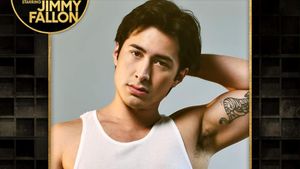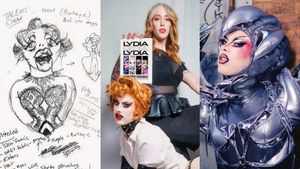In part an aspirational movie about a moment in history and in part a romantic comedy, Greg Berlanti’s Fly Me to the Moon, about the race between the United States and Russia to be the first to land on the moon, provides what now feels like an impossible rime of hope to come together over a single cause. It also addresses issues about space travel and the environment and hands back stories to women, queer people, and BIPOC people excluded from the national story of the moon landing. If that weren’t enough, it offers some justice to much-maligned black cats.
“When you look back at this moment, it was still a very controversial moment. And the PR of it was very important because they were spending so much money on this race with Russia, and people were poor, and people were struggling in the country…but it did bring the country together in the achievement of it,” says Channing Tatum, who plays Cole Davis, the lead engineer working on the moon launch, Apollo 11, and whose secondary mission is to rid NASA of the black cat that keeps crossing his path at work.
“I think it's more of a reminder that we are all in this together, not just in this country, but this world. And it's really easy to feel very myopic about your life because we all have struggles. It doesn't matter where you are and who you are. Everybody understands pain and suffering and love or the lack of love or the lack of stuff and just on different levels of degree. If we could all just try to get together more and understand that about each other, I think that would be helpful,” he adds.
 Jim Rash and Scarlett Johansson in Fly Me to the Moon Sony Pictures
Jim Rash and Scarlett Johansson in Fly Me to the Moon Sony Pictures
The film, from writer Rose Gilroy, begins amid enthusiasm for the space program flagging, given the nation's economic situation and the war in Vietnam. To reinvigorate interest, the government, via Woody Harrelson’s Moe Berkus, enlists the help of a marketing genius, Kelly Jones, played with a dash of feminist ideals, panache, and one-liners at the ready by Scarlett Johansson. With the help of her assistant Ruby Martin (Anna Garcia), a bit of a rabble-rouser who slams then-President Richard Nixon and the space program as environmentally deleterious, Kelly gives NASA’s image a makeover worthy of a Hollywood ending. Meanwhile, she and Cole butt heads while falling for each other.
“I think that especially in period pieces, that’s not really a voice you often hear of someone that’s sort of … raging against the machine in many ways, especially in a rom-com, there’s not that much political ... the fact that I get to shit-talk Richard Nixon is amazing,” Garcia says. “It was really fun, and I think I relate to her a lot in that way too. Getting to play a proud feminist was great.”
 Channing Tatum and Scarlett Johansson in Fly Me to the MoonSony Pictures
Channing Tatum and Scarlett Johansson in Fly Me to the MoonSony Pictures
As Apollo 11’s mission becomes a reality and the decision is made to film the moon landing to be broadcast live, Moe pushes Kelly to hire a director to fake the moon landing, the “OG conspiracy theory,” Berlanti says. Enter Lance Vespertine (Jim Rash), a gay auteur director and Kelly’s friend, who goes to great lengths to shoot the perfect fake moon landing. But Lance is more than a stock gay character in a 1960s-era flick. It’s just a line in the film, but Kelly alludes to Lance’s boyfriend early on, establishing that he’s got a rich home life that he shares with his friends.
“Just that one little throwaway boyfriend line was important to me. It was 1969. It was obviously an important moment in gay history as well. That was LGBT history that was happening at the same moment,” Berlanti, the gay wunderkind producer (Riverdale, The Flash, Arrow) and Love Simon director, says. “And I didn’t want to disregard those moments in history; although they’re not at the center of the film, you wanted to know that there were these elements and characters who were in this story. It didn’t feel like a movie we would’ve made in 1969. It’s a movie we would make today about then with a real reason to go back.”
 Jim Rash, Scarlett Johansson, and Anna Garcia in Fly Me to the MoonSony Pictures
Jim Rash, Scarlett Johansson, and Anna Garcia in Fly Me to the MoonSony Pictures
Out actor Rash, whose Lance is nearly as much of a scene-stealer as the film’s stray cat, says of his character, “I love that Lance was unapologetic about who he was. And I think with Greg behind the helm, it was like, No, this is who he is. And he was not shy about it. And I think it's a wonderful thing.”
Johansson, who helped spearhead the project with her production company These Pictures, says that giving voice to the Fly Me to the Moon characters who would have been on the margins in the late 1960s expands the film’s reach.
“It’s interesting because when you look at photos of NASA, even when we’re looking like, Oh, what did the room look like and how do you cast all the background for it? And it's just very homogenized,” Johansson says. “Being able to show the side of the story that are the creative minds that are looking at things in this bigger picture … and are able to sprinkle the magic on this and sell this huge idea, and really, the creative brain behind this massive effort to be able to tell that other side with these characters that are so strong and not recognized. … That's what makes the film. It makes it such a bigger picture than what it I think, traditionally is, which can be very narrow.”
As for the cat that Cole is convinced is bringing bad luck to his mission, without spoiling it, the cat has a role in saving the day. Berlanti and the cast were fans of working with the felines.
“These cats [three for production] in the film. They were so well-behaved and trained. I didn't know you could really train a cat. We talked about it, because they get bored of food. They just are disinterested and they're like, what will you give me now?” Johansson says. “They were lucky cats for us. They delivered basically every time. I was like, these cats are incredible.”


 Jim Rash and Scarlett Johansson in Fly Me to the Moon Sony Pictures
Jim Rash and Scarlett Johansson in Fly Me to the Moon Sony Pictures Channing Tatum and Scarlett Johansson in Fly Me to the MoonSony Pictures
Channing Tatum and Scarlett Johansson in Fly Me to the MoonSony Pictures  Jim Rash, Scarlett Johansson, and Anna Garcia in Fly Me to the MoonSony Pictures
Jim Rash, Scarlett Johansson, and Anna Garcia in Fly Me to the MoonSony Pictures



































































Charlie Kirk DID say stoning gay people was the 'perfect law' — and these other heinous quotes